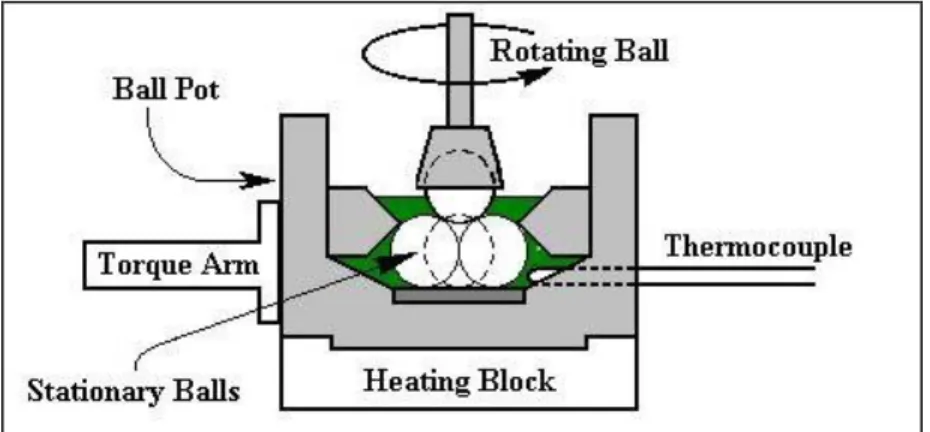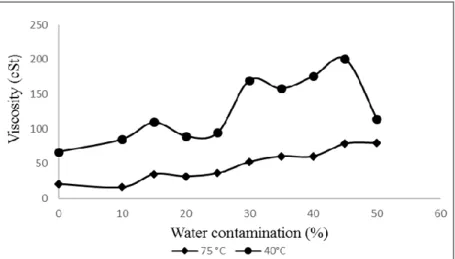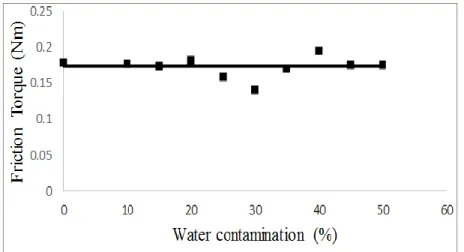Received 30 Dec 2014; received in revised form 24 Mac 2015; accepted 2 May 2015.
To cite this article: Syahirah et al. (2015). Friction and wear of bearing material under water contaminated compressor oil. Jurnal Tribologi 5, pp.11-21.
Friction and wear of bearing material under water contaminated compressor oil
M.N. Syahirah*, A.N. Farhanah, M.Z. Bahak
Faculty of Mechanical Engineering, Universiti Teknologi Malaysia, 81310 UTM Skudai, Johor, Malaysia.
*Corresponding author: diksyira91@gmail.com
HIGHLIGHTS
Engine oil from three different manufacturers with the same SAE viscosity grade available in market does not mean it will have the same lubricity for an engine.
The best lubricant performance would have minimum friction and wear at the same time able to operate at any temperature.
ABSTRACT
Water has been defined as a destructive contaminant which may cause a detrimental impact on bearing performance. Nevertheless, many previous studies only made the research after the lubrication failure occurred, but they also only focused on the contaminated lubricant, but not on the new lubricant which may be taken as a preventive measure before bearing life will be reduce. Thus, experiment was conducted to identify the effect of water contamination to the lubrication performance of the compressor oil. Four ball tester was used by following standard test methods ASTM 4172 to determine the friction and wear characteristics of water contaminated lubricant. Water contamination was varied from 0% to 50% by volume percentage. The result indicates that water contamination give more effect on wear scar diameter and only has small effect on friction coefficient.
Keywords:
1.0 INTRODUCTION
The term of “lubricant” is defined as a substance or fluids to be applied on the surface which in contact together, especially in machinery parts to reduce the friction. From Webster’s Dictionary Definition, it states that friction is the force which opposes the movement of surface sliding or rolling between moving mechanical parts in contact. In other words, friction is the resistance to motion which exists when a solid object is moved tangentially to the surface hence, when it touches or attempt it will produce such motion (Rabinowicz, 1965). The continuous process of friction will increase the temperature and at certain points it will become wear. Wear will cause the machine temperature to rise up and vibrate. However, when the contamination enters into the bearing system, it will influence the bearing life.
In industrial sector, they have spent million dollars each year to upgrade their filtration technology in order to reduce the contamination while for advanced company, by controlling fluid cleanliness, it may reduce the failure up to 90 percent. Water is found to be more dangerous contaminant rather than solid particles and may destroy the bearing efficiency. Besides, most industrial oils such as hydraulic fluids and turbine oils may hold 200 ppm to 600 ppm of water in the dissolved state than new oil (Noria Corporation, 2001). Water can present in three states or phase which is dissolve water, free water and emulsified water. According to SKF, “It is well-known that free water in lubricating oil decreases the life of rolling element bearings by ten to more than a hundred times ….”. Presence of water in lubricant will lead into a corrosive conditions and diminished boundary layer and hydrodynamic protection (Fitch and Jaggernauth, 1994). The most dangerous phases of water contamination are free and emulsified water. For instance, the incompressibility of water in journal bearings may influence the lubricant film hence affect the process of wear. The life of journal bearing will be reducing about 90% although it only has one percent of water in oil. However, for rolling bearing the situation become more deteriorates in which not only destroy the oil film strength, but also raising the temperature and pressure that generated in the load zone later flash-vaporization which influence erosive wear to occur. Hence, this study is carried out in order to identify the effect of water contamination to the new compressor oil (EP VDL 68). The viscosity, friction torque and wear are measured for different volume percentage of water contaminations varied from 0 percent to 50 percent.
2.0 MATERIALS AND METHODS
2.1 Experimental Procedure
was shown in Figure 1. The viscosity of water contaminated oil was measured by using viscometer while optical microscope was used to determine the microstructure of the wear scar. The variable for this experiment is the percentage of water contaminated by volume fraction while the other parameter has kept constant such as speed, temperature and load. The test samples of water contaminant were performed at various water contaminations which is 0%, 5%, 10%, 15%, 20%, 25%, 30%, 35%, 40%, 45% and 50% were compared. Table 1 show the experimental condition of this experiment while Table 2 shows the information about the tested ball.
Figure 1: Schematic diagram of four ball test machine
Table 1: Experiment parameter
Parameter Value
Normal load 392 N
Time (Duration) 60 minutes
Temperature 75 °C
Speed 1 200 rpm
Table 2: Information of the tested ball
Specification Explanation
Test ball material Three chrome alloy steel
Size Diameter of 12.7 mm
Grade 25 EP (extra polish)
3.0 RESULTS AND DISCUSSION
3.1 Dynamic Viscosity Test
Viscosity is the most important property that distinguishes the characteristic of oil. Viscosity of oil plays a vital role to separate two moving surfaces completely by a fluid film. Previous studies showed that viscosity is directly proportional with film thickness where an increase in viscosity of the oil increased the film thickness (Joaldo Bezerra et al., 2013). High viscosity will provide thicker film between the contact surfaces since the lubricant does not flow smoothly. On the other hand, higher viscosity sometimes shows that the lubricant has been contaminated and can no longer hold any amount of water (Golshokouh et al., 2014). In this experiment, the contaminated oil turns cloudy during the test. The graph (Figure 2) shows that 45% water contamination at temperature of 40°C, while at 75 °C is at 50% water contamination. This result shows that the relation between water contaminations is directly proportional to the water contaminated oil viscosity. But, in this experiment we only focused at 75°C where the temperature of experiment is conducted.
Figure 2: Effect of water contamination on viscosity of oil at 40 °C and 75°C
3.2 FrictionTorque Analysis
reducing the friction (Joaldo Bezerra et al., 2013). These findings are consistent with Hoglund, which stated that lubricant properties lead to the formation of lubricating film in order to reduce the friction between the contact surfaces in elastohydrodynamic (EHD) lubrication in gears, bearing and cams. Furthermore, the properties of the EP-additive in lubricants may operate in higher loads and sliding speeds that coexist in contact whereby the protective film were developed to adhere the surfaces. Hence, the film shear stress reduces the friction by decreasing the shear strength of interaction under boundary lubrication condition as a result of the chemical reaction between EP-additive material and the contact of the surface area (Hoglund, 1999). Besides, EP-additive is required to reduce friction, wear control and prevent the surface from damage. The additives serve by chemical reaction during sliding metal surfaces that will prevent from direct contact between sliding metals. In addition, most additives do not reduce the friction at the contact surfaces but it prevents the welding formation or otherwise it will lead to extensive surface damage (Summer-Smith, 1994).
Figure 3: Effect of water contamination on friction torque
3.3 Wear Scar Diameter
Figure 4: Effect of water contamination on wear scar diameter
3.4 Flash Temperature Parameter
Flash temperature analysis (FTP) is defined as less possibility of lubricant film to break down. The high value of FTP shows that the lubricant has higher performance. The FTP values were calculated by using equation 1 [9].
4 . 1 d
W
FTP (1)
where W is load in kilogram and d is wear scar diameter in millimeter.
Figure 5 shows that the FTP values reduces from 0% to 10% and then with a small fluctuation increased from 10% to 40% of water contamination before finally reduced at 50%. FTP has the lowest temperature and occurs with increased heat that caused by friction between two moving surfaces (Piekoszewski et al., 2001). At this temperature, the lubricant starts to evaporate and continuously leads the lubricant film between contacted surfaces to be reduced. Hence, the contact surfaces will become closer together. Water contamination may destruct the lubricant film to flow smoothly hence more contact surfaces will occur.
3.5 Relation between friction torque and wear scar diameter (WSD)
of friction have an inverse relationship. These findings also consistent with other research which found that friction and wear were occurs due to the effect of degradation of the removal, surface-lubricant system’s physical and chemical characteristics (Bowden and Tabor, 1939). Energy of friction is generated by two moving surface in contact resulted from plastic deformation of material. Plastic deformation will generate lattice vibrations and continuously converted to heat. Friction that occurs between the top ball and the lower three stationary balls will generate more heat. Heat generation between contact surfaces will affect the formation of wear on the tested balls.
Figure 5: Effect of water contamination on flash temperature parameter (FTP)
Figure 6: Relationship between coefficient of friction and wear scar diameter on water contamination
Greiner, 1992). This is due to several mechanisms where the sacrificial films within a short lifetime are formed and broken continuously and cause the wear rates to be higher, although the friction may be low. Moreover, Fox proposed that at very low concentration of oil, the surface is not completely covered by an absorbed film, which the film is not strong enough to resist the combination of load and shear due to its coherent and disorder state as a result of increasing wear which was observed.
3.6 Microstructure of Wear Scar Diameter (WSD)
By comparing the average microstructure of wear scar diameter (WSD) from 0% to 50%, it shows that when the water contamination increased, the wear scar lines on ball specimen will also increase (Table 3). This figure also shows that the ball bearing surface wear circular after the experiment. Besides, the edge of the wear scar slightly ragged and obscured by metal. Furthermore, abrasive wear was found on the ball surfaces where there are deep grooves and small pits around the specimen.
Table 3: Microstructure of wear scar diameter (WSD)
Water contamination
(%)
Wear scar diameter (mm)
(ball 1)
Wear scar diameter (mm)
(ball 2)
Wear scar diameter (mm)
(ball 3)
0
0.31mm 0.11mm 0.11mm
10
15
0.22mm 0.20mm 0.22mm
20
0.15mm 0.15mm 0.49mm
30
0.22mm 0.22mm 0.21mm
35
0.20mm 0.20mm 0.23mm
40
45
0.22mm 0.22mm 0.24mm
50
0.14mm 0.43mm 0.15mm
CONCLUSION
This research showed that viscosity is directly proportional to percentage of water contamination. The experimental results showed that water contamination has small effect on friction torque. Wear scar diameter was higher at 10% and 20% of water contamination. The results also indicate that compressor oil with higher water contamination gives effect more on wear scar diameter (WSD) rather than friction torque.
ACKNOWLEDGEMENT
The author acknowledges Faculty of Mechanical Engineering, Universiti Teknologi Malaysia for their support during this study.
REFERENCES
ASTM D4172. Standard test method for wear preventive characteristics of lubricating fluid (four-ball method).
Bowden, F.P. and Tabor, D., 1939. The area of contact between stationary and between moving surfaces. Proceedings of the Royal Society of London. Series A, Mathematical and Physical Sciences, 169, 391-413.
Fitch, J.C. and Jaggernauth, S., 1994. Moisture—the second most destructive lubricant contaminant and its effect on bearing life. P/PM Technology, 50-53.
Golshokouh, I. and Syahrullail, S., Farid Nasir Ani and Masjuki, H.H., 2014. Investigation of palm fatty acid distillate oil as an alternative to petrochemical-based lubricants. Journal of Oil Palm Research, 26(1), 25-36.
Greenwood, J.A. and Alliston-Greiner, A.F., 1992. Surface temperatures in a fretting contact. Wear, 155, 269-275.
Hoglund, E., 1999. Influence of lubricant properties on elastohydrodynamic lubrication. Wear, 232, 176-184.
Joaldo Bezerra, C.J., Sylvio Jose, R.D.O., Letícia Maria, S.M.L. and Luiz Fernando, L., 2013. Investigation of lubrication performance in four-ball machine tests of lubricants for industrial gear transmissions. 22nd International Congress of Mechanical Engineering (COBEM 2013), Ribeirão Preto, SP, Brazil.
Lane, T.B., 1957. The flash temperature parameter: A creation for accessing E.P. performance in the four-ball machine. J. Inst. Petrol, 43, 181-184.
Noria Corporation, Water in Oil Contamination, 2001. Machinery Lubrication, 7, 21-25. Piekoszewski, W., Szczerek, M. and Tuszyinski, W., 2001. The action of lubricants under
extreme pressure conditions in a modified four ball-tester. Wear, 249, 188-193. Rabinowicz, E., 1965. Friction and Wear Materials. Cambridge, Massachuseets: John
Willey & Sons,Inc.





